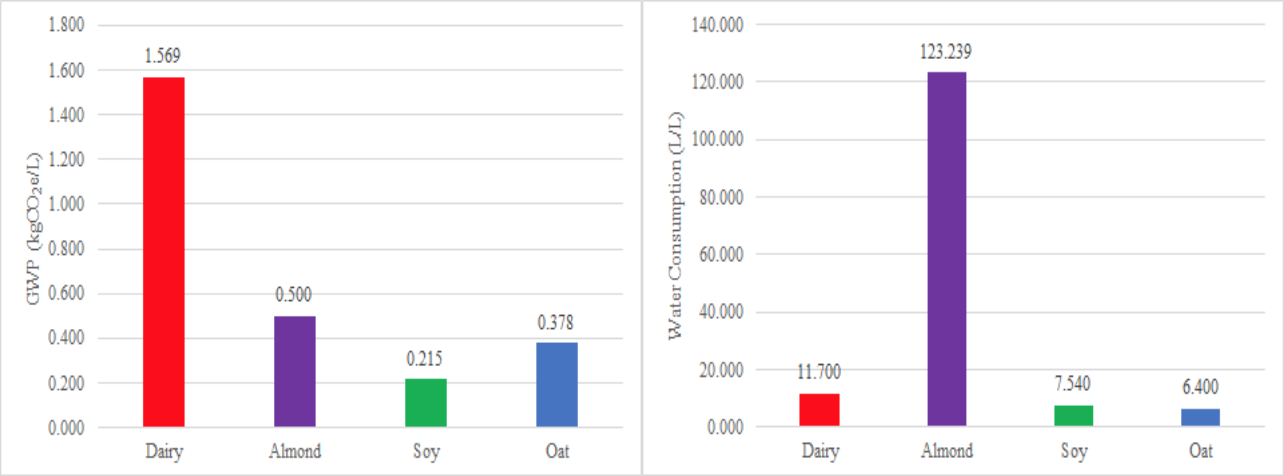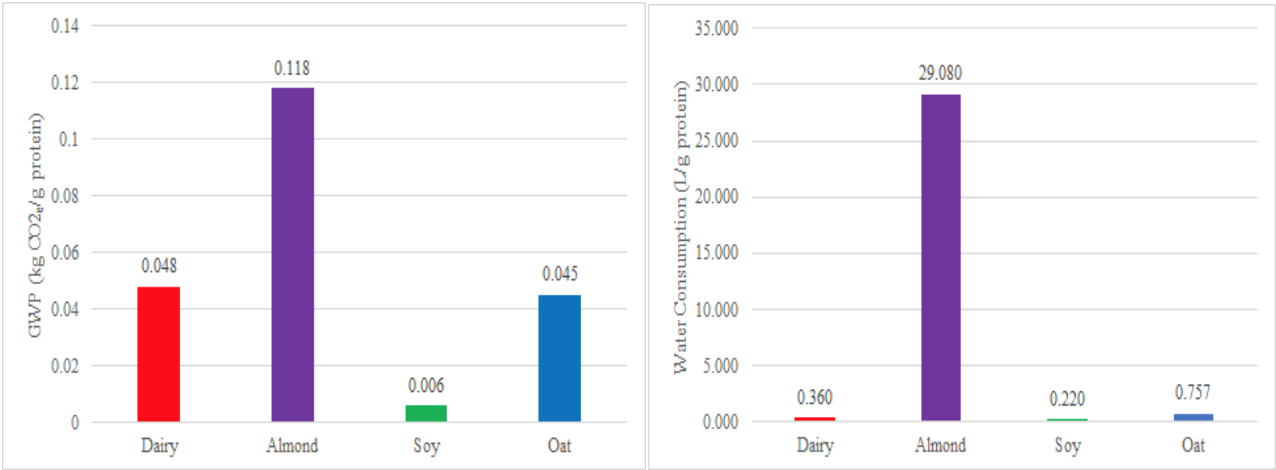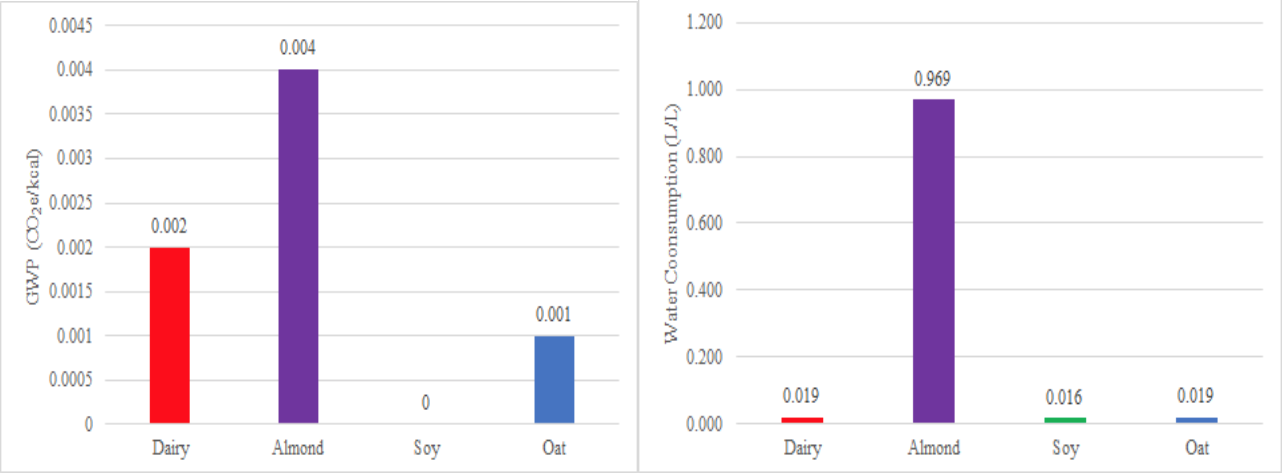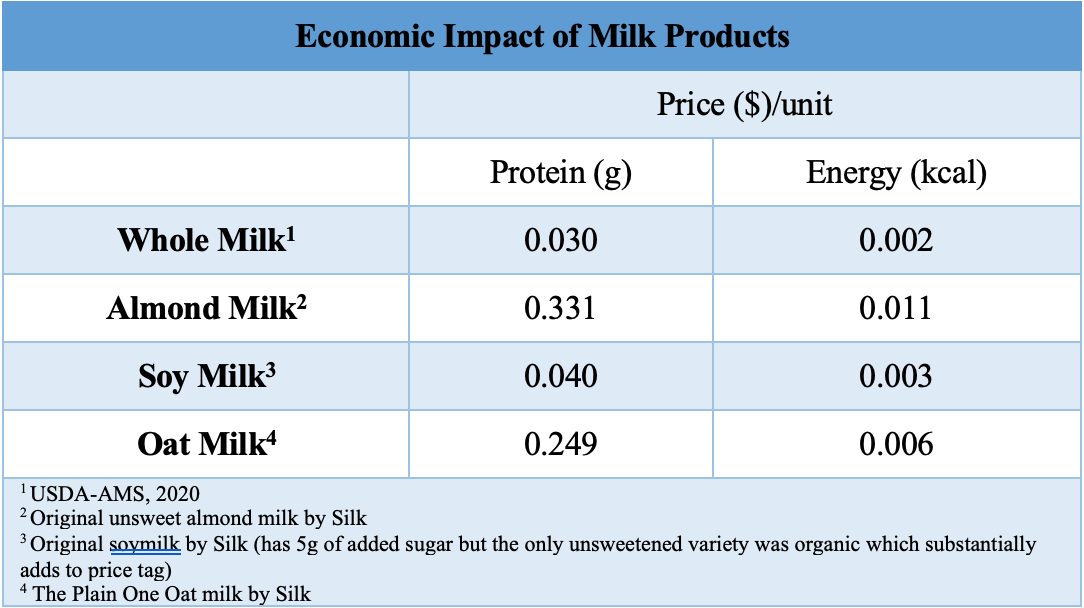Team I: Assessing Milk Product Sustainability for Consumers in the United States: Dairy Milk vs. Three Plant-Based Alternatives
Note/disclaimer: This webpage is for instructional purposes only and the scenario described below is fictional.
This page was developed as a hypothetical report for Consumer Reports.
UW-Madison Task Force Members:Ashley Cate, MS Student in Life Sciences Communication
Erin Hepp, BA Student in People-Environment Geography
Morgan Robinson, MS Student in Environment and Resources
Scenario | Abstract | Introduction | Methods | Results | Limitations | Conclusions | Citations | Acknowledgements | About the Authors |
Scenario
We are researchers for Consumer Reports working to provide information for consumers looking for the best milk purchase. We have compared and contrasted three plant-based milk alternative options to the traditional dairy milk option.
Abstract
In the past decade, the dairy industry in the United States has been rapidly transformed, leading to an increase in milk production and a decrease in overall cow numbers. During this time, consumer preferences have shifted towards non-dairy milk alternatives, putting many small farms out of business and creating an increased concentration of large dairy farms. Alternative plant-based milk products have become more popular for a number of reasons, and the dairy milk industry has suffered from decreased consumer demand. The increasing popularity of alternative milk products has led to concerns about their sustainability, as well as the future of the dairy industry. By reviewing economic, environmental, and social data related to dairy milk and three plant-based alternatives (almond, soy, and oat), this study aims to identify the most sustainable product for consumers. The findings indicate that dairy milk is the most economically sustainable and oat milk may be the most environmentally sustainable, while social sustainability ultimately depends on consumer values.
Introduction
Animal agriculture has undergone a massive transformation since the middle of the 1940s, and the post-World War II agricultural scene has been defined by an increase in efficiency, made possible largely in part by the adoption of new technologies and the specialization of farming systems. The global dairy industry is extremely regulated (albeit with differences from country to country) and it is worth over $400 billion (Franklin-Wallis, 2019). Over the last half century, the dairy industry in the United States has undergone massive policy changes, which have pushed for the intensification of production, as well as price setting by retailers (Clay et al., 2020). Over the past decade, the costs of production (particularly for feed, land, and water) have steadily increased, and dairy farms are becoming increasingly concentrated; in the U.S. and Europe, thousands of small farms have gone out of business, leading to the exponential growth of herd sizes on larger farms (Clay et al. 2020). The overproduction of dairy milk, coupled with retailer-controlled milk pricing and a decrease in consumer demand, has led to narrow profit margins for dairy farmers and an economic crisis within the dairy industry in the U.S. (Ibid.). It is important to note that even though dairy milk consumption is decreasing in the developed world, it is still increasing in developing countries (Ibid.; Roos et al., 2016).
As the dairy industry has experienced an increase in production despite a decrease in cow numbers, consumer preferences have shifted towards non-dairy milk alternatives, leading to an increase in the number of milk alternatives available. These plant-based milk alternatives include almond, soy, and oat, but also include milks made from “coconut, pea, hemp, and other grains, seeds, nuts, and legumes” (Clay et al., 2020). The market for these alternatives is booming: between 2012 and 2017, the sale of these products increased by 60% in the U.S., and between 2018 and 2023 it is expected to increase by upwards of USD $12 billion (Mintel, 2019; Clay et al., 2020; Winans et al., 2020). In the U.S. currently, these alternative milks account for 14% of the total milk sales (Mintel, 2019). Alternative milks have been popular in other places throughout history, but only recently have they gained traction in the United States and other western markets, due in large part to changes in marketing that promote them as healthier, more environmentally friendly options.
There are a number of reasons consumer preferences have shifted away from dairy milk, including dietary restrictions, changing food choices for environmental, ethical, or health reasons, preferences based on age, and the transformation of marketing strategies for alternative products (Makinen et al., 2016; Clay et al., 2020; Roos et al., 2016; Winans et al., 2020; Mintel, 2019). Therefore, assessing the sustainability of milk products can be complex, given that the life cycle assessments (LCAs) of different products do not always use the same system boundaries, impact categories, or functional units. An analysis of multiple LCAs, in conjunction with information gathered from peer-reviewed articles, news articles, government reporting agencies, and product websites, should provide consumers with a useful guide for navigating the milk product market. The ultimate goal of this study is to compare and contrast the sustainability of dairy milk to plant-based alternatives (almond, soy, and oat milk), with the hope of identifying a product that is, overall, the most environmentally, economically, and socially sustainable.
Literature Review
Intensification and specialization of agriculture: From the year 1975 to 2000, U.S. milk production increased 76%, despite an overall drop in cow numbers from 22 million cows in 1950 to 9.2 million in 2000 (Blayney, 2002). According to the USDA’s 2017 Census of Agriculture, there are currently 9.5 million milk cows being housed at 54,599 farms (USDA-NASS, 2019). Such advances in efficiency were made possible by the intensification and specialization in farming practices. from 2007 to 2017, dairy farms were able to reduce manure outputs by 20%, nitrogen outputs by 17%, phosphorus outputs by 14%, CH4 emissions by 20%, and N20 emissions by 18% (Capper and Cady, 2019) compared to the outputs of the 1940s. The number of dairy farms in the U.S. is continuing to decrease every year, while the number of cows has plateaued and remains the same, which means that milk production is occurring on a smaller number of larger farms (Blayney, 2002). In 1993, “large” farms, or farms housing at least 100 milk cows, in the U.S. were home to just over 50% of all milk cows and produced 55% of the milk, whereas “large” farms housed almost 60% of the cows and produced 71.1% of the milk in 2000 (Ibid.). Even more recent data (USDA-NASS, 2019) reports that, as of 2017, 7.3 million milk cows (77% of all the milk cows in the U.S.) are being housed on “large” farms. As dairy production became more intensified and specialized over the years, and the overall number of farms in operation began to decline, farming jobs and services became scarce as people began to search for new opportunities in urban areas. This has resulted in less than 1% of the US workforce currently being involved in a farming experience (Guehlstorf, 2008; Weber et al., 1995). The increasing distance placed between the general public and livestock producers, in combination with agricultural modernity, has contributed to noticeable scrutiny regarding the impact of dairy production on the environment, public health, and the welfare of production animals.
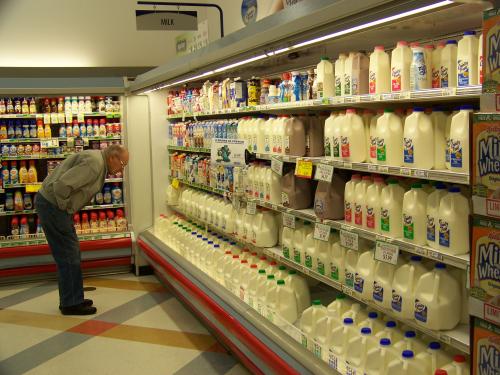
Threats to the Social and Environmental Sustainability of Dairy Milk:
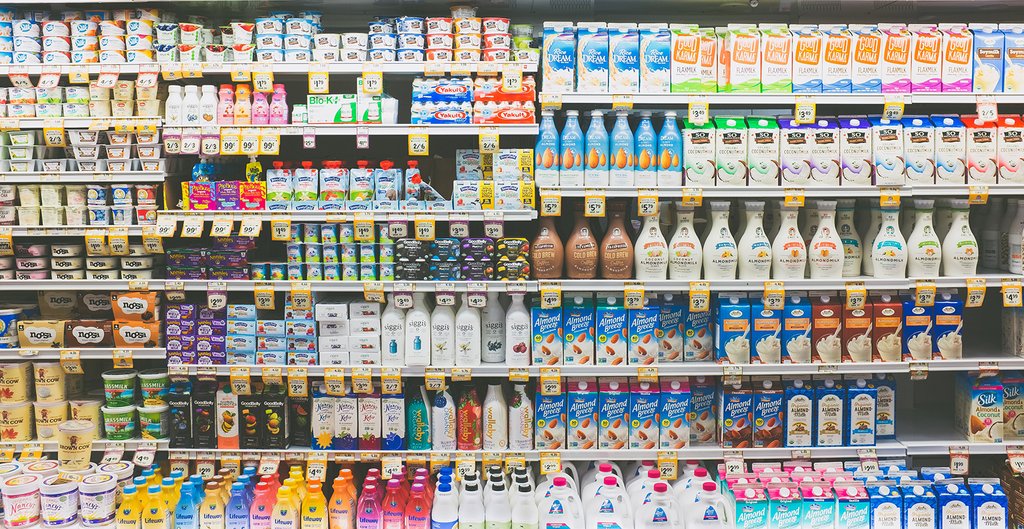
Plant-Based Milk as a More Environmentally & Socially “Acceptable” Alternative: In recent years, the media has identified non-dairy “milks” as a more sustainable and responsible alternative to traditional dairy (Kateman, 2019; Krietsch, 2020). Dairy milk sales have dropped from about $19 billion in 2014 to $15 billion in 2019, while non-dairy milk sales have increased from $1.7 billion in 2014 to $2.4 billion in 2019 (Mintel, 2019). The non-dairy market is full of options, and the media has identified some of the best alternatives, regarding the health of humans and the environment, to be almond, soy, and oat milks (Krietsch, 2020). However, as these plant-based alternative products become more popular, there is some question regarding their sustainability. The production of soybean has been identified as one of the leading drivers of deforestation, particularly in the Amazon basin, and the displacement of small farmers and indigenous people around the world (World Wildlife Fund, 2020; Yale School of Forestry & Environmental Studies, 2020). A single glass of almond milk requires more water than the typical shower, which is particularly problematic considering most almond production occurs in the drought-prone state of California (Guibourg and Briggs, 2019). Additionally, when compared to traditional dairy milk, the consumer must pay almost double for almond and soymilk and about two and a half times more for oat milk (Settembre, 2019).
Hypotheses
The primary objective of this research is to discern the environmental, economic, and social sustainability of dairy milk in comparison to the plant-based alternatives almond, soy, and oat; therefore, it is hypothesized that:
H1: Some plant-based milk alternatives will offer less environmental sustainability than others, but overall plant-based milk alternatives will be more environmentally sustainable than dairy milk.
H2: Due to increases in efficiency and productivity, dairy milk will be more economically sustainable than plant-based alternatives.
H3: Considering the weighted impact of environmental and economic sustainability on social sustainability, it is anticipated that plant-based milk alternatives will offer themselves as more socially sustainable alternatives to dairy milk.
H4: Although there will be variation among each aspect of sustainability for the individual products, plant-based milk alternatives will be considered more sustainable, overall, than dairy milk.
Methods
Data for this study was gathered from academic journals, government reporting agencies, news media, and alternative milk product websites. Instead of conducting new interviews or surveys with consumers, this research is a meta-analysis of peer reviewed literature and existing life cycle assessments (LCAs are used to measure sustainability by assessing the environmental impacts of all stages from production through processing). This research also includes the nutritional information, economic data, and social viability associated with each product, so as to compile the most comprehensive set of information for consumers. The standardization of sustainability values across all of the products was required to answer the research questions and equally compare dairy milk to the plant-based milk alternatives.
To assess economic sustainability, the nutritional information was collected from government regulatory agencies and companies that produce the relevant products; the USDA for whole milk and Silk brand (owned by Danone) for almond, soy, and oat milk. Silk brand was chosen because it is the most popular brand of alternative milks sold in the U.S. (Mintel, 2019). To measure environmental sustainability, LCAs (from Oatly and peer-reviewed sources) were consulted, in addition to product information collected from Silk and the USDA. Using quantitative data collection methods allowed for the compilation of the relative environmental, economic, and social values for each product.
Results
Environmental Aspects: It was hypothesized that even though some plant-based milk alternatives would offer less environmental sustainability than others, overall, plant-based milk alternatives would be more environmentally sustainable than dairy milk.
Figure 1 demonstrates that dairy has a much higher impact (1.569 kgCO2e/L) compared to almond, soy, and oat (0.500 kgCO2e/L, 0.215 kgCO2e/L, and 0.378 kgCO2e/L product, respectively) when considering Global Warming Potential (GWP) on the basis of volume (kgCO2e/L product).
Figure 2 shows that changing the functional unit to consider GWP on the basis of protein content (kgCO2e/g protein) changes the relative environmental impact of dairy (0.048 kgCO2e/g protein) to be much lower than the impact of almond (0.118kgCO2e/g protein) and similar to oat (0.045 kgCO2e/g protein). That said, soy still maintains the lowest environmental impact (0.006 kgCO2e/g protein).
Figure 3 shows the similar effects that occur when considering GWP on the basis of caloric content (kgCO2e/kcal). When considering environmental impact on the basis of water consumption per liter of product, gram of protein, and caloric content (figures 1, 2, and 3, respectively), almond milk maintained a much greater level of impact, while dairy, soy and oat had similar, lower-level impacts.
Economic Aspects: As predicted, due to increases in efficiency and productivity, dairy milk is considered to be more economically sustainable than the plant-based alternatives. The functional units used were dollar/gram of protein and dollar/calorie.
Figure 4 shows that the price per unit (in either protein or energy) is the lowest for whole milk, and it is therefore the most economical. Soymilk is comparable, but almond and oat milks are far more expensive.
Social Aspects: An analysis of peer-reviewed articles, product websites, and news media related to the milk alternatives industry shows that plant-based milk alternatives are presented as more socially and environmentally sustainable when compared to dairy milk. Milk alternatives are often advertised as healthier, more ethical, options. This is in contrast to the historical framing of milk as an affordable, palatable, and healthful option.
Limitations
Since this research was conducted as a meta-analysis of peer-reviewed articles and life cycle assessments, there were a few limitations. The most pressing and difficult problem was attempting to standardize the system boundaries from the previously conducted research of LCA inputs and outputs. Additionally, defining the functional unit proved to be a challenge, because every change in the functional unit creates a change in the product’s sustainability; in other words, the results vary depending on the units used. The functional unit can change the environmental impact, so it really depends on what the consumer is purchasing the product for. Because of this, it was important, albeit difficult, to standardize the system boundaries.
A further limitation concerns the social impacts of these products. When assessing the social sustainability of these products, the health of dairy industry and farm workers was not accounted for. As these are important social issues that should be taken into account, it would be advisable to consider the human impact of these production systems. Future studies should focus on the social and cultural impacts of dairy and alternative milk production, especially in emerging product markets, such as oat milk. Other social concerns that were not taken into account include flexitarian diets and hybrid milk products, two subjects that may be of greater importance in future studies.
Despite these limitations, this research is valid because it uses reliable peer-reviewed sources and combines previous studies to produce a summary of results that are generalizable and useful to the average consumer. These findings matter because they will help consumers make the most sustainable choices for their lifestyle. Additionally, by providing a summary of the environmental issues associated with dairy and three plant-based alternatives, consumers may be able to more easily recognize greenwashing, and avoid products that are not actually environmentally sustainable, or as “green” as they claim to be.
Conclusion
Citations
Blayney, D. (2002) “The changing landscape of U.S. milk production.” USDA Statistical Bulletin No. SB-978. US Department of Agriculture Economic Research Service, Washington, DC. https://www.ers.usda.gov/webdocs/publications/47162/17864_sb978_1_.pdf?v=4105. Accessed 20 March 2020.
Busch, G., Weary, D. M., Spiller, A., von Keyserlingk, M. A. G. (2017) “American and German attitudes towards cow-calf separation on dairy farms.” PLoS One 12(3):1-20. doi:10.1371/journal.pone.0174013
Capper, J. L. and Cady, R. A. (2019) “The effects of improved performance in the U.S. dairy cattle industry on environmental impacts between 2007 and 2017.” Journal of Animal Science 1-14. doi:10.1093/jas/skz291
Cardoso, C. S., Hötzel, M. J., Weary, D. M., Robbins, J. A., von Keyserlingk, M. A. G. (2016) “ Imagining the ideal dairy farm.” Journal of Animal Science 99:1663-1671. doi:10.3168/jds.2015-9925
Clay, N., Sexton, A. E., Garnett, T., and Lorimer, J. (2020) “Palatable Disruption: the Politics of Plant Milk.” Agriculture and Human Values https://doi.org/10.1007/s10460-020-10022-y
EPA (United States Environmental Protection Agency). (2017) “Sources of Greenhouse Gas Emissions.” https://www.epa.gov/ghgemissions/sources-greenhouse-gas-emissions. Accessed 21 March 2020.
Franklin-Wallis, O. (January 2019) “White Gold: The Unstoppable Rise of Alternative Milks.” The Guardian https://www.theguardian.com/news/2019/jan/29/white-gold-the-unstoppable-rise-of-alternative-milks-oat-soy-rice-coconut- plant. Accessed 28 March 2020.
Guehlstorf, N. P. (2008) “Understanding the scope of farmer perceptions of risk: Considering farmer opinions on the use of genetically modified (GM) crops as a stakeholder voice in policy.” Journal of Agricultural and Environmental Ethics 21(6):541-558.doi:10.1007/s10806-008-9116-7
Guibourg, C. and Briggs, H. (2019) “Climate change: Which vegan milk is the best?” BBC News https://www.bbc.com/news/science-environment-46654042. Accessed 23 March 2020.
Kateman, B. (2019) “Non-Dairy Milk Alternatives Are Experiencing A ‘Holy Cow!’ Moment.” Forbes https://www.forbes.com/sites/briankateman/2019/08/19/non-dairy-milk-alternatives-are-experiencing-a-holy-cow-moment/#43dcb3384c44. Accessed 23 March 2020.
Krietsch, B. (2020) “The Best Milk Alternatives For Your Health (And The Environment).” The Huffington Post https://www.huffpost.com/entry/best-milk-alternatives-health-environment_l_5e0e5465c5b6b5a713b7aed2. Accessed 23 March 2020.
Makinen, O. E., Wanhalinna, V., Zannini, E., and Arendt, E. K. (2016) “Foods for Special Dietary Needs: Non-dairy Plant-based Milk Substitutes and Fermented Dairy-type Products.” Critical Reviews in Food Science and Nutrition 56: 339– 349.
Mintel. (2019, October) “Milk and Non-Dairy Milk - U.S. - October 2019.” Accessed 02 February 2020 from Mintel Reports database.
Place, S. E. and Mitloehner, F. M. (2010) “Invited Review: Contemporary environmental issues: A review of the dairy industry’s role in climate change and air quality and the potential of mitigation through improved production efficiency.” Journal of Animal Science 93:3407-3416. doi:10.3168/jds.2009-2719
Robbins, J. A., Weary, D. M., Schuppli, C. A., von Keyserlingk, M. A. G. (2015) “Stakeholder views on treating pain due to dehorning dairy calves.” Animal Welfare 24(4):399-406. doi:10.7120/09627286.24.4.399
Schuppli, C. A., von Keyserlingk, M. A. G., Weary, D. M. (2014) “Access to pasture for dairy cows: Responses from an online engagement.” Journal of Animal Science 92(11):5185-5192. doi:10.2527/jas.2014-7725
Settembre, J. (2019) “Plant-based milk may be double the price but people are drinking it up.” New York Post https://nypost.com/2019/07/18/plant-based-milk-may-be-the-double-the-price-but-people-are-drinking-it-up/. Accessed 23 March 2020.
Sharpley, A. N., Smith, S. J., Naney, J. W. (1987) “Environmental impact of agricultural nitrogen and phosphorous use.” Journal of Agricultural Food Chemistry 35(5):812-817. doi:10.1021/jf00077a043
Thoma, G., Popp, J., Nutter, D., Shonnard, D., Ulrich, R., Matlock, M., Kim, D. S., Neiderman, Z., Kemper, N., East, C., Adom, F. (2013) “Greenhouse gas emissions from milk production and consumption in the United States: A cradle-to-grave life cycle assessment circa 2008.” International Dairy Journal 31:S3-S14. doi:10.1016/j.idairyj.2012.08.013
Thomas, M. (2018) “Mapping Factory Farm Investigations in America.” Opposing Views https://www.opposingviews.com/category/putting-factory-farm-investigations-on-the-map. Accessed 20 March 2020.
USDA-NASS (US Department of Agriculture National Agricultural Statistic Service). (2019) “2017 Census of Agriculture – United States Data.” Pages 19- 20. https://www.nass.usda.gov/Publications/AgCensus/2017/Full_Report/Volume_1,_Ch apter_1_US/st99_1_0011_0012.pdf. Accessed 03 Nov. 2019.
Weber, G. M., Hoban, T. J., Kendall, P. A., Bull, L. S. (1995) “Consumer concerns about modern technology in agriculture: Considerations for undergraduate and graduate teaching.” Journal of Animal Science 73:2727–2732. doi:10.2527/1995.7392727x
Winans, K. S., Macadam-Somer, I. Kendall, A., Geyer, R., Marvinney, E. (2019) “Life cycle assessment of California unsweetened almond milk.” The International Journal of Life Cycle Assessment 25:577-587.doi:10.1007/s11367-019- 01716-5
World Wildlife Fund (2020) “Sustainable Agriculture: Soy.” https://www.worldwildlife.org/industries/soy. Accessed 23 March 2020.
Yale School of Forestry & Environmental Studies (2020) “Soy Agriculture in the Amazon Basin.” https://globalforestatlas.yale.edu/amazon/land-use/soy. Accessed 23 March 2020.
Acknowledgements
This project would not have been successful without the contributions of the outstanding students in our Food Systems and Sustainability class, as well as the instructional team. We would particularly like to acknowledge the wonderful and challenging questions, and the specific knowledge that students with different areas of expertise provided.
About the Authors
Ashley Cate is a graduate student receiving a Masters in Life Sciences Communication.
Erin Hepp is an undergraduate student receiving a Bachelor of Arts in People-Environment Geography.
Morgan Robinson is a graduate student receiving a Masters in Environment and Resources.
 and this is Michel.
and this is Michel.
